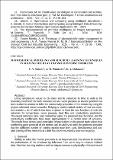Search
Mathematical modeling and machine learning techniques in solving the heat transfer inverse problems
| dc.contributor.author | Sidorov, V. N. | |
| dc.contributor.author | Primkulov, A. M. | |
| dc.contributor.author | Makarova, E. A. | |
| dc.coverage.spatial | Брест | ru_RU |
| dc.date.accessioned | 2025-09-02T14:10:53Z | |
| dc.date.available | 2025-09-02T14:10:53Z | |
| dc.date.issued | 2025 | |
| dc.identifier.citation | Sidorov, V. N. Mathematical modeling and machine learning techniques in solving the heat transfer inverse problems / V. N. Sidorov, A. M. Primkulov, E. A. Makarova. – Text : direct // Строительство – формирование среды жизнедеятельности = Construction – the formation of living environment FORM 2025 : сборник статей XXVIII Международной научной конференции, Брест, 23–25 апреля 2025 г. / Министерство образования Республики Беларусь, Министерство науки и высшего образования Российской Федерации ; Брестский государственный технический университет, Национальный исследовательский Московский государственный строительный университет ; редколлегия: Н. Н. Шалобыта, И. П. Павлова, Н. В. Черноиван [и др.]. – Брест : БрГТУ, 2025. – ISBN 978-985-493-659-8. – P. 9–21. – Bibliography: 13 titles. | ru_RU |
| dc.identifier.uri | https://rep.bstu.by/handle/data/49393 | |
| dc.description.abstract | Using temperature values in 2D-space and its variations in time as well as the boundary conditions for both temperatures and vapor pressure an inverse problem has been studied in attempt to infer the conductivity properties of the domain by using the physics informed neural networks. Relying on mathematical models of heat and moisture transfer а set of criteria has been proposed to form the loss functions to train the networks for temperature, vapor pressure, heat flux and conductivity predictions. The neural networks have been trained by using the proposed loss functions and the conductivity coefficients have been approximated to a certain level of accuracy. The results have shown good correlation of predictions to the ground truth values thus confirming good potential of the method and its ability to solve the problems provided that the sufficient number of training epochs have been used. Simultaneous and coupled training of few networks at a time has shown expectedly slow convergency. | ru_RU |
| dc.language.iso | en | ru_RU |
| dc.publisher | БрГТУ | ru_RU |
| dc.title | Mathematical modeling and machine learning techniques in solving the heat transfer inverse problems | ru_RU |
| dc.type | Научный доклад (Working Paper) | ru_RU |
| dc.identifier.udc | 004.9 | ru_RU |
